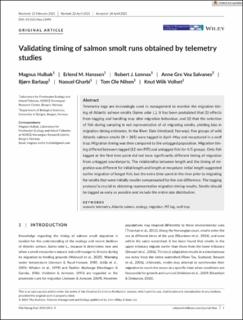| dc.contributor.author | Hulbak, Magnus Andre | |
| dc.contributor.author | Hanssen, Erlend Mjelde | |
| dc.contributor.author | Lennox, Robert | |
| dc.contributor.author | Salvanes, Anne Gro Vea | |
| dc.contributor.author | Barlaup, Bjørn Torgeir | |
| dc.contributor.author | Gharbi, Naouel | |
| dc.contributor.author | Nilsen, Tom Ole | |
| dc.contributor.author | Vollset, Knut | |
| dc.date.accessioned | 2022-04-08T09:37:29Z | |
| dc.date.available | 2022-04-08T09:37:29Z | |
| dc.date.created | 2021-07-16T16:01:34Z | |
| dc.date.issued | 2021 | |
| dc.identifier.issn | 0969-997X | |
| dc.identifier.uri | https://hdl.handle.net/11250/2990729 | |
| dc.description.abstract | Telemetry tags are increasingly used in management to monitor the migration timing of Atlantic salmon smolts (Salmo salar L.). It has been postulated that (1) effects from tagging and handling may alter migration behaviour, and (2) that the selection of fish during sampling is not representative of all migrating smolts, yielding bias in migration timing estimates. In the River Dale (Vestland, Norway), five groups of wild Atlantic salmon smolts (N = 385) were tagged in April–May and recaptured in a wolf trap. Migration timing was then compared to the untagged population. Migration timing differed between tagged (12 mm PIT) and untagged fish for 4/5 groups. Only fish tagged at the first time point did not have significantly different timing of migration from untagged counterparts. The relationship between length and the timing of migration was different for initial length and length at recapture; initial length suggested earlier migration of longer fish, but the extra time spent in the river prior to migrating for smolts that were initially smaller compensated for the size difference. The tagging protocol is crucial to obtaining representative migration timing results. Smolts should be tagged as early as possible and include the entire size distribution. | en_US |
| dc.language.iso | eng | en_US |
| dc.publisher | Wiley | en_US |
| dc.rights | Navngivelse 4.0 Internasjonal | * |
| dc.rights.uri | http://creativecommons.org/licenses/by/4.0/deed.no | * |
| dc.title | Validating timing of salmon smolt runs obtained by telemetry studies | en_US |
| dc.type | Journal article | en_US |
| dc.type | Peer reviewed | en_US |
| dc.description.version | publishedVersion | en_US |
| dc.rights.holder | Copyright 2021 The Author(s) | en_US |
| cristin.ispublished | true | |
| cristin.fulltext | original | |
| cristin.qualitycode | 1 | |
| dc.identifier.doi | 10.1111/fme.12495 | |
| dc.identifier.cristin | 1921960 | |
| dc.source.journal | Fisheries Management and Ecology | en_US |
| dc.source.pagenumber | 428-436 | en_US |
| dc.identifier.citation | Fisheries Management and Ecology. 2021, 28 (5), 428-436. | en_US |
| dc.source.volume | 28 | en_US |
| dc.source.issue | 5 | en_US |

